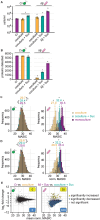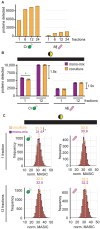This is a preprint.
Mono-mix strategy enables comparative proteomics of a cross-kingdom microbial symbiosis
- PMID: 40777375
- PMCID: PMC12330575
- DOI: 10.1101/2025.07.22.666210
Mono-mix strategy enables comparative proteomics of a cross-kingdom microbial symbiosis
Abstract
Cross-kingdom microbial symbioses, such as those between algae and bacteria, are key players in biogeochemical cycles. The molecular changes during initiation and establishment of symbiosis are of great interest, but quantitatively monitoring such changes can be challenging, particularly when the microorganisms differ greatly in size or are intimately associated. Here, we analyze output from data-dependent acquisition (DDA) LC-MS/MS proteomics experiments investigating the well-studied interaction between the alga Chlamydomonas reinhardtii and the heterotrophic bacterium Mesorhizobium japonicum. We found that detection of bacterial proteins decreased in coculture by 50% proteome-wide due to the abundance of algal proteins. As a result, standard differential expression analysis led to numerous false-positive reports of significantly downregulated proteins, where it was not possible to distinguish meaningful biological responses to symbiosis from artifacts of the reduced protein detection in coculture relative to monoculture. We show that data normalization alone does not eliminate the impact of altered detection on differential expression analysis of the cross-kingdom symbiosis. We assessed two additional strategies to overcome this methodological artifact inherent to DDA proteomics. In the first, we combined algal and bacterial monocultures at a relative abundance that mimicked the coculture, creating a "mono-mix" control to which the coculture could be compared. This approach enabled comparable detection of bacterial proteins in the coculture and the monoculture control. In the second strategy, we enhanced detection of lowly abundant bacterial proteins by using sample fractionation upstream of LC-MS/MS analysis. When these simple approaches were combined, they allowed for meaningful comparisons of nearly 10,000 algal proteins and over 4,000 bacterial proteins in response to symbiosis by DDA. They successfully recovered expected changes in the bacterial proteome in response to algal coculture, including upregulation of sugar-binding proteins and transporters. They also revealed novel proteomic responses to coculture that guide hypotheses about algal-bacterial interactions.
Keywords: Dual-proteomics; chlorophyte; label-free quantitation; mixed cultures; rhizobia; shotgun proteomics.
Figures





Similar articles
-
Prescription of Controlled Substances: Benefits and Risks.2025 Jul 6. In: StatPearls [Internet]. Treasure Island (FL): StatPearls Publishing; 2025 Jan–. 2025 Jul 6. In: StatPearls [Internet]. Treasure Island (FL): StatPearls Publishing; 2025 Jan–. PMID: 30726003 Free Books & Documents.
-
Sexual Harassment and Prevention Training.2024 Mar 29. In: StatPearls [Internet]. Treasure Island (FL): StatPearls Publishing; 2025 Jan–. 2024 Mar 29. In: StatPearls [Internet]. Treasure Island (FL): StatPearls Publishing; 2025 Jan–. PMID: 36508513 Free Books & Documents.
-
Home treatment for mental health problems: a systematic review.Health Technol Assess. 2001;5(15):1-139. doi: 10.3310/hta5150. Health Technol Assess. 2001. PMID: 11532236
-
Automated monitoring compared to standard care for the early detection of sepsis in critically ill patients.Cochrane Database Syst Rev. 2018 Jun 25;6(6):CD012404. doi: 10.1002/14651858.CD012404.pub2. Cochrane Database Syst Rev. 2018. PMID: 29938790 Free PMC article.
-
Signs and symptoms to determine if a patient presenting in primary care or hospital outpatient settings has COVID-19.Cochrane Database Syst Rev. 2022 May 20;5(5):CD013665. doi: 10.1002/14651858.CD013665.pub3. Cochrane Database Syst Rev. 2022. PMID: 35593186 Free PMC article.
References
-
- Hungate Robert E.. The Rumen and its Microbes. Elsevier; 1966. doi: 10.1016/C2013-0-12555-X - DOI
Publication types
Grants and funding
LinkOut - more resources
Full Text Sources
Research Materials
